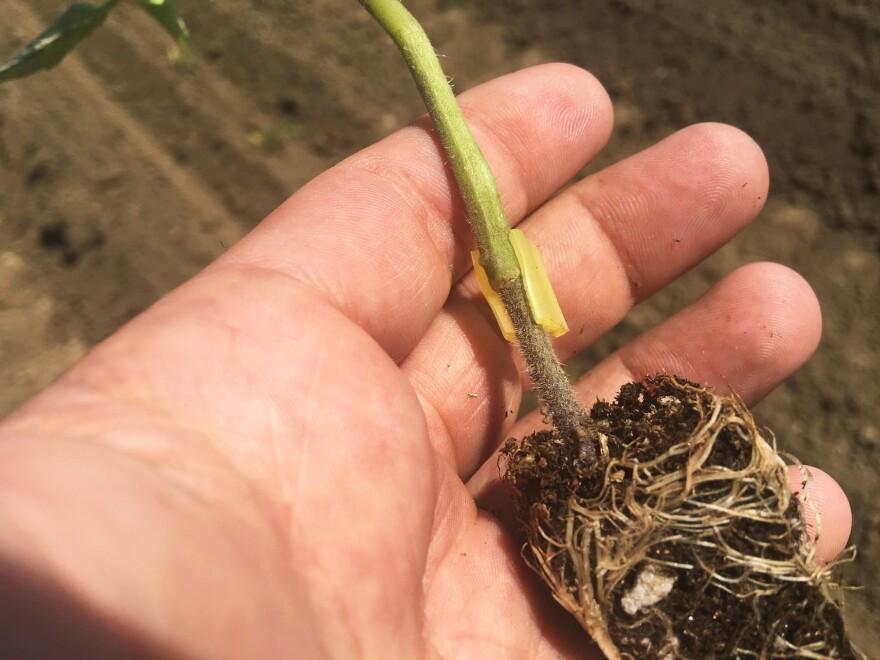is an expert when it comes to tomatoes. He plants rows and rows of tomatoes outdoors on farms across central California for the University of California Cooperative Extension.
They're the kind of tomatoes that "end up on sandwiches at Subway," Stoddard says. "Also, at any of your common hamburger places, In-N-Out, McDonald's, you name it."
Right now, those tomatoes taste fine and yield plenty. But Stoddard wishes they were more flavorful and produced an even larger crop. And he thinks he's found a way to do this by using a new twist on an old technique: grafting.
On a farm about an hour north of Fresno, Calif., Stoddard and a crew of farmworkers are testing out this theory. They're planting rows of about 3,500 tomato seedlings. But unlike the rest of the tomato plants grown in this field — or almost any outdoor field in California — these tiny shoots are grafted.
He's working with common commercial tomato varieties, bred for their hardiness and ability to hold up during shipment, but not so much for their taste. He is taking these high-yielding tomato plants, which are naturally resistant to insects and disease, and cutting off their tops. Then, he places the tip of a weaker — but tastier — commercial tomato plant into the exposed tissue. The plants live in a greenhouse for a couple months, where they slowly fuse together before they're ready for planting.
"Now we got them in the field, and so approximately 83 days from now, if all goes according to plan, we will be harvesting out here and we will see if we can see some yield differences," Stoddard says.
Grafting is used for all sorts of trees in agriculture — think peaches, almonds, nectarines — to help fight off soil-borne diseases and insects. But it's used less commonly for plants like tomatoes in large-scale outdoor production — mostly, says Stoddard, because the industry isn't sure it's economical. Grafting requires more time and labor, because farmers have to grow two plants and keep them in hothouses longer before they're ready to go in the ground.
But Stoddard says grafting has been successful in boosting yields in tomatoes grown in greenhouses — which, of course, are a much more controlled environment. Will the same practice work outdoors? "That's what we're testing to see if that's true," Stoddard says.

He's fairly certain the crop will take off, but he needs to make sure grafting will pan out economically before he recommends the practice to the big commercial growers he advises. He says since grafted plants are more expensive than regular seedlings, he will need to see at least a 30 percent increase in yield.
"They are very price sensitive," Stoddard says. "This is why it's experimental. So we do this on a very small basis and see if there's something potentially there that the growers might end up taking and moving on with."
About 150 miles north of the farm where Stoddard's plants are growing, — a UC Cooperative Extension small farm adviser for Solano, Sacramento and Yolo counties — is also grafting tomato plants. But she's working with several heirloom varieties, prized for their rich flavor — and grafting them on insect- and disease-resistant plants.
"We're kind of working at this level of finding nonchemical management tools that will help overcome these challenges, so [farmers] can continue to grow these nice heirloom varieties," says Lloyd.
Lloyd says heirloom tomatoes have a harder time fighting off disease and can easily bruise or break open, so they can't ship very far. Since these tomatoes are staying local, farmers tend to let the fruit ripen on the vine longer. She says that's one reason why heirloom tomatoes at the farmers market tend to be tastier than store-bought tomatoes, which are likely picked before they're ripe.
On a field at UC Davis, Lloyd has planted a quarter-acre of grafts of some of the most common heirloom types — Brandywine, Cherokee purple and Marvel Stripe — as well as the yellow Sun Gold Cherry tomato and a salad variety called Charger.
"We're trying to understand some of the initial questions about whether these heirloom varieties that we're interested in can be grafted and how these combinations might perform under our environmental conditions," says Lloyd.
Just like Stoddard, Lloyd is collecting data from the trial to see if grafting makes sense for the growers she represents. Lloyd and Stoddard agree that, if both projects are successful, consumers could, in time, have a tastier, larger assortment of tomatoes for purchase in stores and at farmers markets.
Ezra David Romero reports for in central California.
Copyright 2021 Valley Public Radio. To see more, visit . 9(MDEwMTk5OTQ0MDEzNDkxMDYyMDQ2MjdiMw004))


